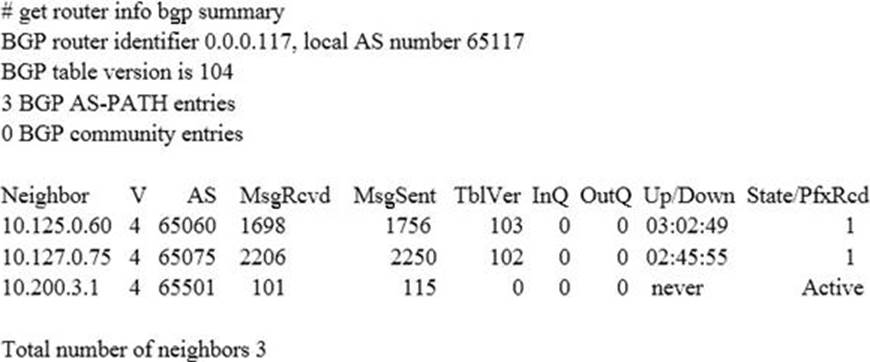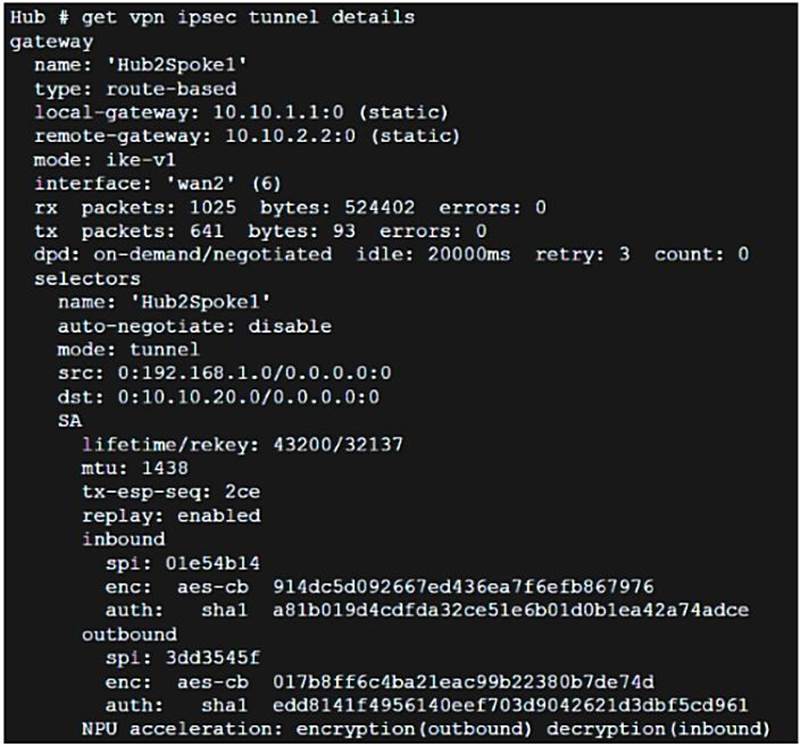Fortinet NSE7_EFW-7.0 Fortinet NSE 7 – Enterprise Firewall 7.0 Online Training
Fortinet NSE7_EFW-7.0 Online Training
The questions for NSE7_EFW-7.0 were last updated at Dec 26,2025.
- Exam Code: NSE7_EFW-7.0
- Exam Name: Fortinet NSE 7 - Enterprise Firewall 7.0
- Certification Provider: Fortinet
- Latest update: Dec 26,2025
Which two statements about the Security Fabric are true? (Choose two.)
- A . Only the root FortiGate collects network topology information and forwards it to FortiAnalyzer.
- B . Only the root FortiGate sends logs to FortiAnalyzer.
- C . Only FortiGate devices with fabric-object-unification set to default will receive and synchronize global CMDB objects sent by the root FortiGate.
- D . FortiGate uses FortiTelemetry protocol to communicate with FortiAnalyzer.
A,C
Explanation:
FortiGate’s to Root uses FortiTelemetry (TCP-8013) FortiTelemetry is also used for FortiClient communication Root Fortigate to FortiAnalyzer uses API (TCP-443)
View the exhibit, which contains the output of a debug command, and then answer the question below.

Which one of the following statements about this FortiGate is correct?
- A . It is currently in system conserve mode because of high CPU usage.
- B . It is currently in extreme conserve mode because of high memory usage.
- C . It is currently in proxy conserve mode because of high memory usage.
- D . It is currently in memory conserve mode because of high memory usage.
Which the following events can trigger the election of a new primary unit in a HA cluster? (Choose two.)
- A . Primary unit stops sending HA heartbeat keepalives.
- B . The FortiGuard license for the primary unit is updated.
- C . One of the monitored interfaces in the primary unit is disconnected.
- D . A secondary unit is removed from the HA cluster.
Examine the output of the ‘get router info bgp summary’ command shown in the exhibit; then answer the question below.

Which statements are true regarding the output in the exhibit? (Choose two.)
- A . BGP state of the peer 10.125.0.60 is Established.
- B . BGP peer 10.200.3.1 has never been down since the BGP counters were cleared.
- C . Local BGP peer has not received an OpenConfirm from 10.200.3.1.
- D . The local BGP peer has received a total of 3 BGP prefixes.
Refer to the exhibit, which contains the output of a BGP debug command.

Which statement about the exhibit is true?
- A . The local router has received a total of three BGP prefixes from all peers.
- B . The local router has not established a TCP session with 100.64.3.1.
- C . Since the counters were last reset, the 10.200.3.1 peer has never been down.
- D . The local router BGP state is OpenConfirm with the 10.127.0.75 peer.
What is the purpose of an internal segmentation firewall (ISFW)?
- A . It inspects incoming traffic to protect services in the corporate DMZ.
- B . It is the first line of defense at the network perimeter.
- C . It splits the network into multiple security segments to minimize the impact of breaches.
- D . It is an all-in-one security appliance that is placed at remote sites to extend the enterprise network.
C
Explanation:
ISFW splits your network into multiple security segments. They serve as a breach containers from attacks that come from inside.
Which two tasks are automated using the Install Wizard on FortiManager? (Choose two.)
- A . Preview pending configuration changes for managed devices.
- B . Add devices to FortiManager.
- C . Import policy packages from managed devices.
- D . Install configuration changes to managed devices.
- E . Import interface mappings from managed devices.
A,D
Explanation:
https://help.fortinet.com/fmgr/50hlp/56/5-6-2/FortiManager_Admin_Guide/1000_Device%20Manager/1200_install_to%20devices/0400_Install%20wizard-device%20settings.htm
There are 4 main wizards:Add Device: is used to add devices to central management and import their configurations.
Install: is used to install configuration changes from Device Manager or Policies & Objects to themanaged devices. It allows you to preview the changes and, if the administrator doesn’t agree with the changes, cancel and modify them.
Import policy: is used to import interface mapping, policy database, and objects associated with the managed devices into a policy package under the Policy & Object tab. It runs with the Add Device wizard by default and may be run at any time from the managed device list.
Re-install policy: is used to perform a quick install of the policy package. It doesn’t give the ability to preview the changes that will be installed to the managed device.
Refer to the exhibit, which contains the partial output of the get vpn ipsec tunnel details command.

Based on the output, which two statements are correct? (Choose two.)
- A . The npu_flag for this tunnel is 03.
- B . Different SPI values are a result of auto-negotiation being disabled for phase 2 selectors.
- C . Anti-replay is enabled.
- D . The npu_flag for this tunnel is 02.
Which two tasks are automated using the Import Configuration wizard on FortiManager? (Choose two.)
- A . Importing firewall address objects from managed devices
- B . Importing interface mappings from managed devices
- C . Importing static and dynamic route configurations from managed devices
- D . Importing devices to FortiManager
A,B
Explanation:
https://docs.fortinet.com/document/fortimanager/7.0.5/administration-guide/337348
An administrator has configured a dial-up IPsec VPN with one phase 2, extended authentication (XAuth) and IKE mode configuration.
The administrator has also enabled the IKE real time debug:
diagnose debug application ike-1
diagnose debug enable
In which order is each step and phase displayed in the debug output each time a new dial-up user is connecting to the VPN?
- A . Phase1; IKE mode configuration; XAuth; phase 2.
- B . Phase1; XAuth; IKE mode configuration; phase2.
- C . Phase1; XAuth; phase 2; IKE mode configuration.
- D . Phase1; IKE mode configuration; phase 2; XAuth.
B
Explanation:
https://help.fortinet.com/fos50hlp/54/Content/FortiOS/fortigate-ipsecvpn-54/IPsec_VPN_Concepts/IKE_Packet_Processing.htm
Latest NSE7_EFW-7.0 Dumps Valid Version with 115 Q&As
Latest And Valid Q&A | Instant Download | Once Fail, Full Refund

